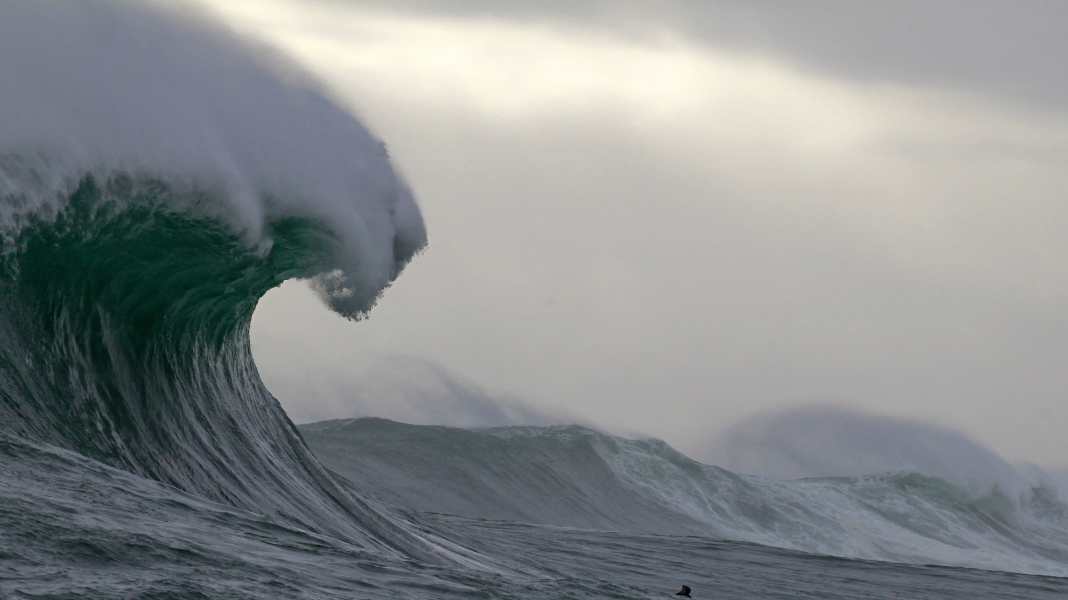
On 21 December 2024, during the height of Storm Eddie, satellites recorded ocean waves with an average height of almost 20 metres - as high as a 6-storey apartment building and commonly referred to as monster waves. It is the highest wave ever measured from space. The measurement was taken in the open North Pacific, far from any coastline, but its significance extends far beyond this single extreme wave.
More than just wave height
What makes this measurement special is not just the sheer height, but the way in which the monster wave was recorded. SWOT stands for "Surface Water and Ocean Topography" and is a joint satellite mission by NASA and the French space agency CNES, which was launched on 16 December 2022. For the first time, large-scale, two-dimensional maps of the ocean surface can be created by satellite. Not only can individual wave heights be measured, but the formation, propagation and energy of monster waves can be tracked over thousands of kilometres. SWOT combines traditional radar altimetry with wide-area imaging to measure the height, length and direction of the swell. The satellite can detect swells as low as 3 centimetres and reveal wavelengths of up to 1,400 metres that other satellite sensors often miss.
However, extreme waves in storms are difficult to measure because satellites are rarely in the right place at exactly the right time. Until now, there were hardly any measurements of waves over 16 metres in height, and little was known about their wave periods (how long it takes for the next wave to arrive).
Fortunately, SWOT flew over the centre of Storm Eddie on 21 December 2024, just as wave heights were peaking, and measured a significant wave height of 19.7 metres - the largest monster wave ever measured by satellite between 1991 and 2024. Since 1991, there has been wave height data from 15 satellites, but until December 2024, these measurements did not exceed 18.5 metres - not because the model overestimated wave heights, but because satellites only sample a very small part of the ocean and generally miss the peak of storms.
Harnessing the swell
The researchers used a trick: They observe the swell, i.e. the waves that travel across the ocean like "wave echoes" after a storm. This swell carries important information about the original storm, even if the storm has long since passed. SWOT can precisely measure and show this swell: In extreme storms, short, steep waves transfer their energy to longer waves. This creates the gigantic monster waves. The long waves then travel as a swell for thousands of kilometres.
According to the study, previous scientific formulas overestimated the energy of the longest ocean waves by a factor of 20. The study corrects these errors and shows: The higher the waves, the longer the time between each wave. For the monster wave of 19.7 metres, this period was around 20 seconds.
The origin of the monster waves
The study found that the biggest monster waves are created in particular storms: those in which the region with high winds moves at the same speed as the waves, giving them the energy they need to grow higher and longer. This concentrated wave energy only lasts a few hours before it spreads across the ocean basins as a swell.
The team was able to track the storm dune across 24,000 kilometres of ocean, from the North Pacific through the Drake Passage to the tropical Atlantic, between 21 December 2024 and 6 January 2025. This means that a storm raging off Alaska can cause dangerous conditions in the Caribbean two weeks later.
Is this really the highest monster wave?
No - there have already been higher measured waves:
- On 8 September 2019, a single wave height of 30.2 metres was measured by a measuring buoy off Newfoundland
- In the southern hemisphere, 23.8 metres were recorded on 8 May 2018 near Campbell Island, south of New Zealand
- The wave triggered by a tsunami in Lituya Bay, Alaska, reached an incredible 524 metres in 1958
- On 29 October 2020, Sebastian Steudtner surfed an officially confirmed 26.21-metre wave off Nazarè - this is the world record for big wave surfing according to Guinness World Records. In February 2024, a new record of 28.57 metres was measured with the help of a drone, and Steudtner also rode this wave. Official recognition by the World Surf League is still pending. These monster waves are created by the "Nazaré Canyon", a sea canyon up to 5,000 metres deep that ends just off the coast. This canyon concentrates the energy of the Atlantic in a very small space and allows waves to reach heights of over 20 metres in winter
But: The wave measured by SWOT is the highest recorded by satellite.
Why the delay until publication?
The measurement took place on 21 December 2024, but was not presented to the scientific public until September 2025. The team's new findings, which were recently published in the journal Proceedings of the National Academy of Sciences, first had to undergo a rigorous scientific review process. The team analysed the swell caused by the largest storms between April 2023 and December 2024.
Importance for sailors
The combination of satellite-based remote sensing and buoy measurements now provides a more complete picture of ocean dynamics. These findings improve weather forecasts, help in the construction of offshore structures and coastal protection, and even enable better analyses of earthquake signals generated by ocean waves. In future, weather routing systems could also take into account not only current storms, but also their far-reaching "wave echoes", thus enabling more reliable forecasts for blue water sailors. Work is also being carried out on AI-supported analyses, such as the University of Copenhagen as well as at the University of Maryland.

